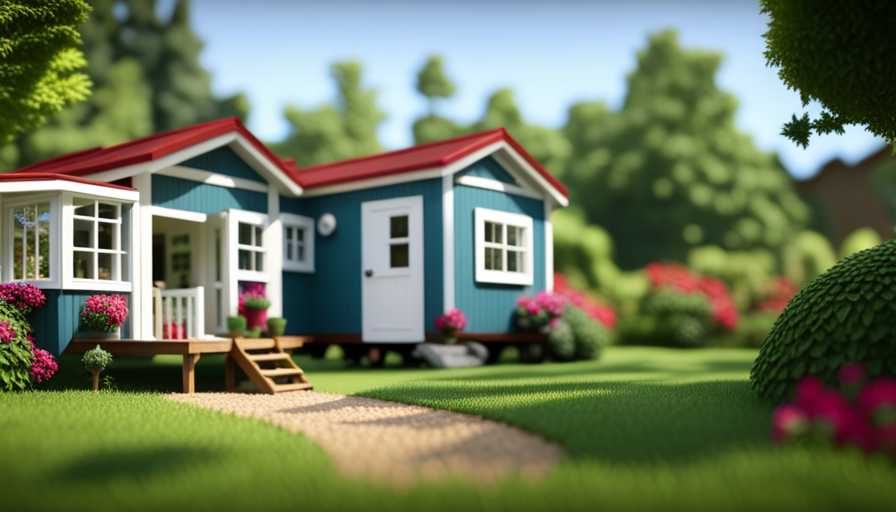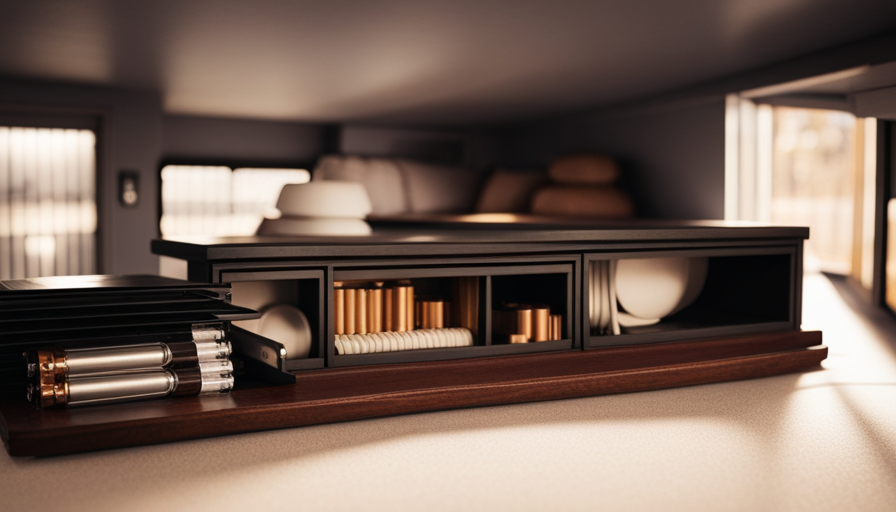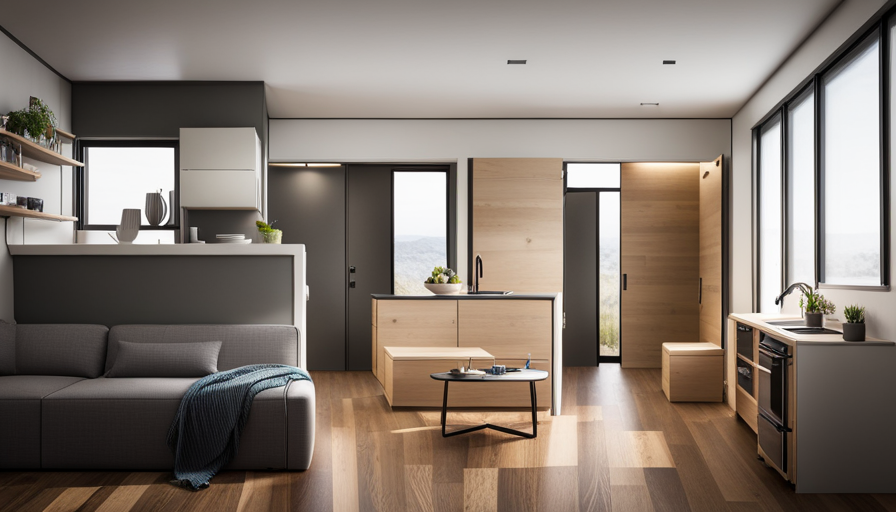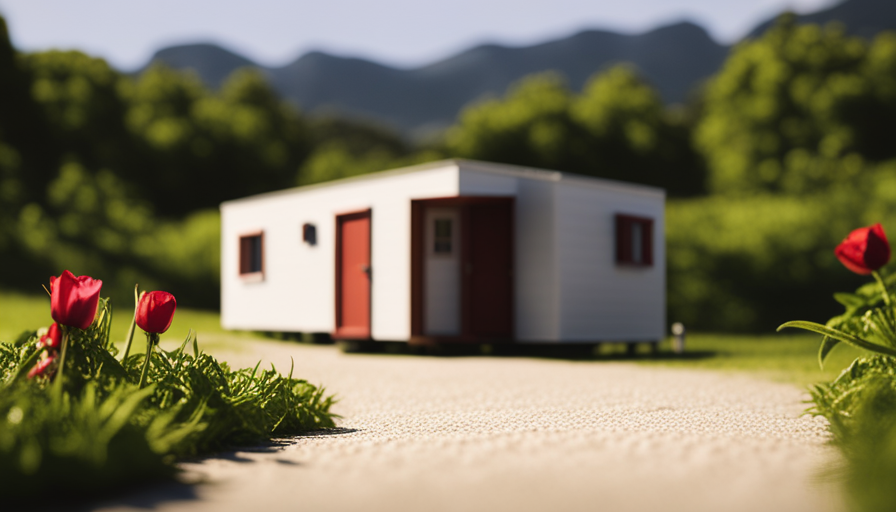Small homes tailored for seniors offer a compelling solution to the challenges of aging in a fast-paced and ever-changing world. These cozy dwellings provide a refreshing departure from the limitations of larger homes, allowing older individuals to simplify their living arrangements.
With cost savings, ease of maintenance, and customization options, tiny houses offer a unique opportunity for older adults to create a space that suits their individual needs and preferences.
In addition, these compact homes prioritize mobility and accessibility, ensuring that older adults can navigate their living space with ease.
Furthermore, the environmental sustainability and energy efficiency of tiny houses contribute to a greener future, while the emotional well-being and mental health benefits of living in a small, cozy space cannot be underestimated.
Ultimately, tiny houses empower older adults to maintain their independence and autonomy as they age gracefully. With resources and support readily available, transitioning to a tiny house lifestyle has never been easier.
Key Takeaways
- Tiny houses for older adults offer a solution to the challenges of aging in a fast-paced world.
- They prioritize mobility and accessibility for older adults.
- Tiny houses contribute to environmental sustainability and energy efficiency.
- Living in a tiny house community provides opportunities for outdoor activities and fosters a sense of belonging.
Downsizing and Simplifying Living Arrangements
If you’re looking to simplify your living arrangements and downsize to a more manageable space, tiny houses provide the perfect solution for older adults. Minimalistic living has become increasingly popular in recent years, and for good reason. Downsizing offers numerous benefits, including reduced maintenance, lower utility costs, and the opportunity to declutter and let go of unnecessary possessions.
By living in a smaller space, older adults can focus on what truly matters and spend less time and money on home upkeep. Additionally, the smaller footprint of a tiny house allows for a smaller environmental impact, which aligns with the growing trend of sustainable living.
The benefits of downsizing go beyond just simplifying living arrangements; it can lead to a more fulfilling and purposeful life. With the advantages of minimalistic living in mind, let’s explore the next section about cost savings and affordability.
Cost Savings and Affordability
Imagine how much money you could save by living in a compact and affordable home tailored to your needs. When considering tiny houses for older adults, cost savings and affordability are key factors to consider. These small homes offer the opportunity for long-term financial implications, as they require less maintenance, utilities, and overall expenses.
With a smaller footprint, tiny houses can be built at a fraction of the cost of traditional homes. However, it’s important to also consider potential challenges and limitations. Downsizing and adjusting to a smaller living space can be a significant change for some individuals. Additionally, finding suitable land to place a tiny house can be a challenge in certain areas.
Despite these considerations, the financial benefits and potential savings make tiny houses an attractive option for older adults.
Transitioning into the subsequent section about ease of maintenance and housekeeping, it is important to note that these factors further contribute to the affordability and practicality of tiny houses.
Ease of Maintenance and Housekeeping
Maintaining and keeping up with a compact and affordable home tailored to your needs is made easier with less square footage to clean and maintain, resulting in a more manageable living space. According to a study conducted by the National Association of Home Builders, smaller homes require about 40% less time for housekeeping compared to larger homes.
The ease of maintenance in tiny houses is attributed to their smaller size, which means less surface area to dust and fewer rooms to clean. Additionally, time-saving strategies such as utilizing multi-functional furniture and storage solutions can further streamline the housekeeping process.
With less time spent on maintenance, older adults can focus on other activities that bring them joy and fulfillment. Moving forward, it’s important to consider the customization and personalization options available in tiny houses to create a living space that’s both functional and reflective of individual preferences and needs.
Customization and Personalization Options
When you create your own compact and affordable home, you can fully personalize and customize the space to reflect your unique style and preferences. The customization options available for tiny houses for older adults are vast, allowing you to design a home that perfectly suits your needs.
- Interior Design: From choosing the color scheme to selecting the furniture and decor, you have the freedom to create a space that aligns with your personal taste. Whether you prefer a minimalist aesthetic or a cozy cottage vibe, the possibilities are endless.
- Storage Solutions: With limited space, it’s crucial to maximize storage options. Tiny houses offer various innovative storage solutions, such as built-in cabinets, hidden compartments, and creative shelving, ensuring that every inch of your home is utilized efficiently.
- Accessibility Features: Tiny houses can be customized to incorporate mobility and accessibility features, such as ramps, wider doorways, and grab bars, making it easier for older adults to navigate their living space comfortably and safely.
When it comes to tiny houses for older adults, customization and personalization choices are key to creating a home that’s uniquely yours. Now let’s explore the next section on mobility and accessibility features.
Mobility and Accessibility Features
Navigating the path of life becomes smoother when your home is thoughtfully designed with mobility and accessibility features tailored to your needs. Universal design principles ensure that these features are integrated seamlessly into the layout and functionality of a tiny house. From wider doorways and hallways to grab bars and handrails strategically placed throughout, every aspect of the home is optimized for easy movement and independence. Additionally, assistive technology can be incorporated to further enhance accessibility, such as voice-activated lights and smart home systems that can be controlled remotely. These features not only promote safety and convenience, but also empower older adults to live comfortably and confidently in their tiny homes. Moving forward, let’s explore the exciting community and social opportunities that come with this lifestyle.
Community and Social Opportunities
Transitioning from the previous subtopic of mobility and accessibility features, it’s important to consider how tiny houses for older adults can provide not only a functional living space, but also opportunities for community engagement and social connectedness.
Living in a tiny house community can foster a sense of belonging and create opportunities for interaction with neighbors. Additionally, these communities often organize social events and activities specifically tailored to the needs and interests of older adults.
The close proximity of the houses and shared common spaces encourage socializing and forming meaningful relationships. Furthermore, being a part of a supportive community can help combat feelings of loneliness and isolation that older adults may experience.
Moving forward, it’s essential to explore how tiny houses can also contribute to environmental sustainability and energy efficiency.
Environmental Sustainability and Energy Efficiency
To truly embrace the sustainable lifestyle of living in a tiny house community, you can take advantage of innovative energy-efficient technologies and eco-friendly practices.
Passive design is a key aspect of environmental sustainability in tiny houses. By strategically positioning windows, insulation, and shading, passive design maximizes natural lighting and minimizes the need for heating and cooling systems.
Additionally, sustainable materials can be utilized in the construction of these houses, such as reclaimed wood, recycled insulation, and low VOC paints. These choices not only reduce the environmental impact but also create a healthier living environment.
By focusing on environmental sustainability and energy efficiency, tiny house communities can be at the forefront of sustainable living.
Transitioning into the next section about emotional well-being and mental health benefits, it is important to recognize how these environmental aspects contribute to a holistic and fulfilling lifestyle.
Emotional Well-being and Mental Health Benefits
Embracing the sustainable lifestyle of living in a tiny house community brings with it a sense of emotional well-being and mental health benefits. The close-knit relationships formed within these communities combat social isolation, providing a support system that promotes a sense of belonging and connectedness.
Additionally, the shared spaces and communal activities foster a sense of purpose and fulfillment, as residents engage in meaningful interactions and collaborative projects. Living in a tiny house encourages a simpler way of life, reducing stress and promoting relaxation. The minimalistic nature of these homes allows for a clutter-free environment, which in turn contributes to a sense of calm and tranquility.
Furthermore, being surrounded by nature in these communities provides opportunities for outdoor activities, promoting physical and mental well-being.
Transitioning into the subsequent section about ‘independence and autonomy in aging,’ the benefits of living in a tiny house community extend beyond emotional well-being and mental health.
Independence and Autonomy in Aging
After exploring the emotional well-being and mental health benefits of tiny houses for older adults, it’s important to delve into another crucial aspect of these unique homes: independence and autonomy in aging.
Tiny houses offer older adults the opportunity to maintain their independence while aging in place. With their smaller size and manageable layouts, these homes allow individuals to easily navigate their living spaces and perform daily tasks without relying on assistance.
Furthermore, living in a tiny house encourages community engagement and social connections. The close proximity to neighbors and shared spaces fosters a sense of belonging and encourages interaction among residents. This social aspect can greatly enhance the quality of life for older adults, reducing feelings of isolation and loneliness.
Transitioning to a tiny house lifestyle requires careful consideration and planning, which brings us to the next section on resources and support for this exciting change.
Resources and Support for Transitioning to a Tiny House Lifestyle
Navigating the transition to a cozy, low-maintenance lifestyle can be made easier with the help of various resources and support systems available. When considering the move to a tiny house as an older adult, there are important financial considerations to keep in mind. Here are four key resources and support systems to assist in the transition:
- Financial Planning Services: Seek out professionals who specialize in financial planning for downsizing and transitioning to a tiny house. They can help create a comprehensive financial plan, considering factors such as the cost of purchasing or building a tiny house, ongoing maintenance expenses, and potential income from downsizing.
- Tiny House Communities: Joining a tiny house community can provide a supportive network of like-minded individuals who have already made the transition. These communities often offer resources such as shared tools, maintenance assistance, and social activities.
- Online Forums and Blogs: Engage with online communities dedicated to tiny house living. These platforms are a treasure trove of information, offering advice on design, construction, and the challenges unique to tiny house living.
- Local Government Support: Research local regulations and building codes related to tiny houses. Some municipalities have embraced the tiny house movement and offer support through zoning changes or incentives for building a tiny house. Contact local officials to learn more.
Navigating the transition to a tiny house lifestyle as an older adult may come with its challenges, but with the right resources and support, it can be a fulfilling and financially feasible choice.
Frequently Asked Questions
Are there any restrictions on where you can park a tiny house for older adults?
There are restrictions on where you can park a tiny house, regardless of whether it’s for older adults or not. These restrictions are mainly based on parking regulations and accessibility requirements.
Local zoning laws and building codes dictate where you can legally park a tiny house. Additionally, accessibility requirements may necessitate certain features or modifications to the parking area to ensure the tiny house is easily accessible for older adults.
How do tiny houses for older adults address medical and healthcare needs?
Addressing healthcare needs in housing involves incorporating a range of accessibility features, such as ramps, grab bars, and wider doorways to accommodate mobility aids. Financial considerations must also be taken into account, as medical expenses can be a burden for older adults.
Social and community support play a crucial role in ensuring access to healthcare services and resources. Additionally, psychological well-being is supported through features that promote a sense of security and independence.
Can you live in a tiny house if you have pets?
Living arrangements in pet-friendly housing can be a viable option for pet owners wanting to downsize. Many housing options, including tiny houses, cater to pet owners by providing suitable spaces for pets to live comfortably. These arrangements often feature pet-friendly amenities such as fenced yards, designated pet areas, and nearby pet-friendly parks.
However, it’s important to research and choose a housing option that meets both the needs of the pet and the owner to ensure a harmonious living environment.
Are tiny houses for older adults suitable for individuals with limited mobility?
Living in a tiny house may seem like a dream, but for individuals with limited mobility, it can come with its limitations. Accessibility is a key concern, as maneuvering through tight spaces and climbing up ladders can be challenging. However, with proper modifications and adaptations, tiny houses can be made suitable for individuals with limited mobility. Ramps, wider doorways, and accessible bathrooms can greatly improve the accessibility of these homes, ensuring a safe and comfortable living environment.
What are the zoning regulations and legal considerations when living in a tiny house?
Zoning regulations and legal considerations play a crucial role when living in a tiny house. Zoning regulations determine where and how a tiny house can be located, ensuring compliance with local laws and regulations. It is important to research and understand the zoning requirements specific to your area before building or purchasing a tiny house.
Additionally, legal considerations such as land ownership, building codes, and permits must be taken into account to ensure a lawful and safe living arrangement.
Conclusion
In conclusion, choosing to live in a tiny house as an older adult offers numerous benefits. While some may argue that the limited space may feel confining, it’s important to consider the freedom and independence it provides.
By downsizing and simplifying, older adults can enjoy a more affordable and manageable living arrangement. Additionally, the customization options allow for personalization, creating a space that truly feels like home.
Embrace the opportunity to live sustainably and enjoy the emotional well-being that comes with a simpler lifestyle.
I’m Theodore, and I love tiny houses. In fact, I’m the author of Tiny House 43, a book about tiny houses that are also tree houses. I think they’re magical places where imaginations can run wild and adventures are just waiting to happen.
While tree houses are often associated with childhood, they can be the perfect adult retreat. They offer a cozy space to relax and unwind, surrounded by nature. And since they’re typically built on stilts or raised platforms, they offer stunning views that traditional homes simply can’t match.
If you’re looking for a unique and romantic getaway, a tree house tiny house might just be the perfect option.










